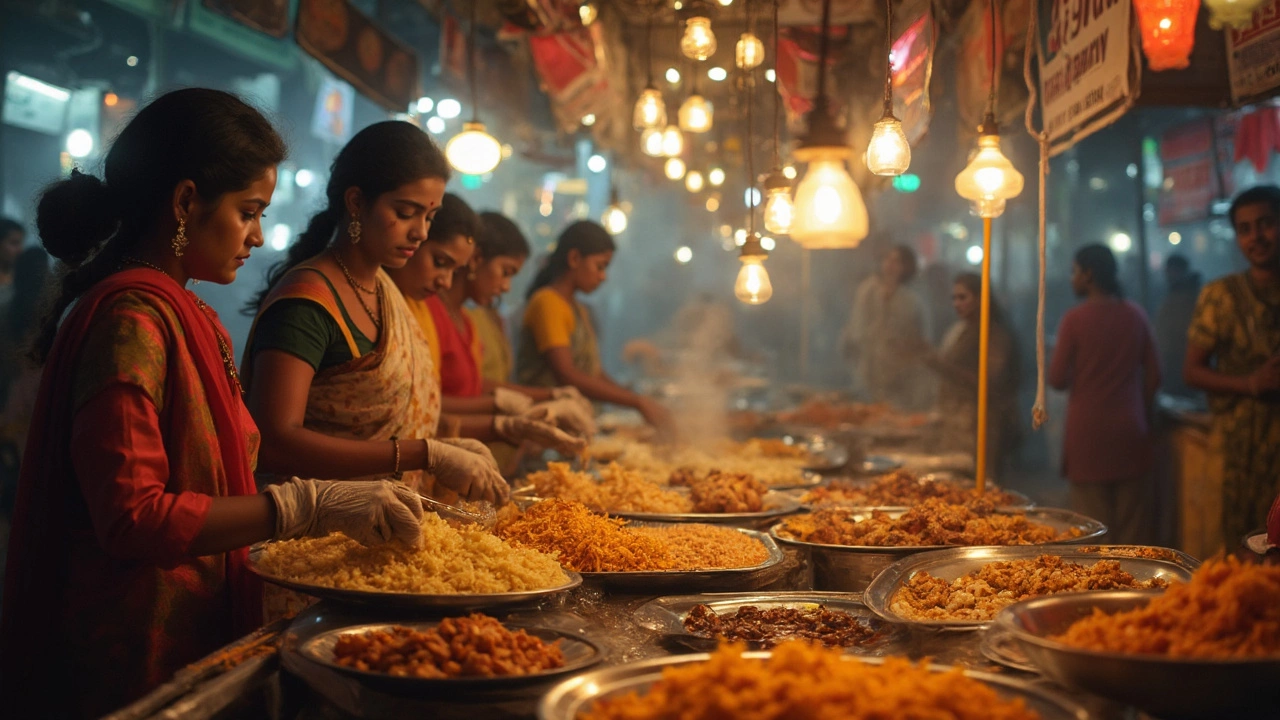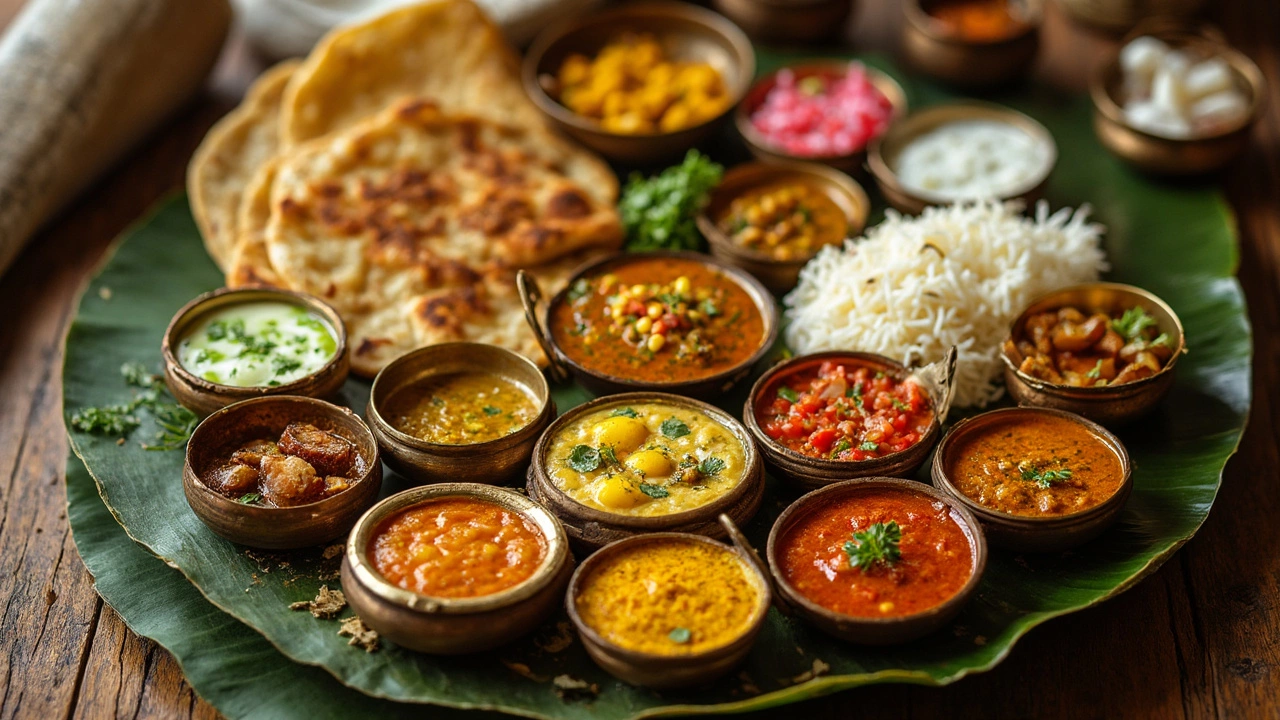Most Popular Indian Foods: Dishes Indians Eat Every Day

Walk into most Indian homes at mealtime, and you'll find a comfort dish that's stood the test of centuries—simple, tasty, and always in demand. But with the sheer variety spread from Kashmir to Kerala, picking just one Indian food as the “most eaten” seems almost impossible at first glance. Still, only a few dishes are so universally loved and popularly eaten that they practically define Indian daily eating. Ready to discover what Indians actually eat most?
The Everyday Staple: Dal Chawal Wins the Numbers Game
If you lined up all the plates in India at lunchtime, one meal would dominate the landscape: dal chawal, or lentils and rice. It's the no-frills, reliable answer to hunger for over a billion people almost daily. Here’s why this humble combo grabs the “most eaten” Indian food title. Dal (lentils) isn’t just cheap; it's also protein-packed, easy to cook, and comes in more varieties than you can count on both hands—think moong, masoor, toor, urad, chana, and more. Rice, on the other hand, is a neutral partner, soaking up the flavors of whatever spice-laden dal is on offer, no questions asked.
Most Indian households whip up dal chawal at least once a day, sometimes twice. The stats prove it: data from the Indian Council of Medical Research shows over 80% of Indian homes feature rice and lentils in their top daily eats. Dal alone comes in dozens of regional avatars—some spiced up with red chilies in the north, others tempered with coconut in the south. The popularity of dal chawal is practical too. When groceries are running low, families stretch it with just some rice, turmeric, salt, and whatever dal is available. On busy weekdays, or even after fancy feasts, folks (like me and Priya) find themselves ladling steaming dal over fluffy rice out of habit, for comfort, and for that mild earthy hit you just crave after a long day.
And don’t think dal chawal is boring. The flavor transforms depending on the lentil, tempering, or region—try Bengali masoor dal for a slightly sweet touch, Punjabi maa ki dal for creamy richness, or Andhra pappu for a light, sour kick thanks to tamarind. From street food joints in Mumbai to rural kitchens in Bihar, dal chawal is the crowd-pleaser.
Here’s a table breaking down dal varieties and their most common pairings:
| Dal Variety | Main State/Region | Typical Pairing |
|---|---|---|
| Toor Dal | Maharashtra, Gujarat | Steamed Rice, Ghee |
| Masoor Dal | Bengal, Odisha | Rice or Roti |
| Urad Dal | Punjab, North India | Rice, Paratha |
| Moong Dal | Everywhere | Rice, Sanwa Millet |
| Chana Dal | North & South India | Jeera Rice, Paratha |
Next time someone mentions Indian food, don’t just picture butter chicken. More than likely, it’s a simple dal chawal quietly feeding the nation.
Bread and Beyond: Chapati, Roti, and the Indian Wheat Story
If you head north and west of India, you see something else taking center stage on the table—a hot, puffed-up roti. Made with whole wheat flour, this flatbread is the backbone of daily eating in states like Punjab, Gujarat, Delhi, Rajasthan, and even parts of central India. My wife Priya grew up calling it ‘phulka’ at home. Whether you say roti, chapati, or phulka, this bread manages to edge out rice in some regions, often acting as both utensil and accompaniment. Indians use fresh rotis to scoop up everything—dals, sabzis (veggie dishes), or tangy chutneys. Want to make a meal stretch? Just do what most Indian moms do—make a few extra rotis.
You’ll barely find a north Indian lunchbox without a stack of neatly wrapped rotis. Wheat production in northern India is massive, and for many, rotis are breakfast, lunch, and dinner. What’s fascinating is the sheer variety—some folks prefer thin, soft chapatis while others go for heartier stuffed parathas or crispier rotis made on a clay tandoor. Rotis also have this magic adaptability: they’re quick to assemble (just flour and water, maybe salt), don’t need fancy tools, and can accompany just about any home-style curry or even leftovers from last night.
If you’re new to making rotis, here’s a tip: start with dough that’s a little sticky and give it a rest before rolling it out. Even if your first attempts are a little oddly shaped, they’ll still taste great dunked in a spicy curry. In big cities, a lot of working professionals order rotis online or get them delivered as part of a “dabba” (home-cooked lunchbox)—another sign of how essential it is to Indian eating habits.
Indians’ connection with roti isn’t just about filling up—it’s about sharing. In many homes, you break roti together at the table, passing dishes around and eating with your hands. There’s a grounding comfort in the routine: roast, puff, serve, repeat. And while rice is king in the south and east, in vast stretches of the country it’s the chappati that rules dinnertime.

The Universal Craze for Biryani: More Than Just a Party Dish
Okay, let’s switch gears and talk about the flashier, party-going cousin of dal chawal—biryani. This is no humble staple. It’s a rich, fragrant rice dish layered with marinated meat (often chicken or mutton), fried onions, saffron, and warm spices. Despite the work it takes to make, biryani is eaten so much across India—with countless local twists—that it arguably deserves a solid spot on this list. Hyderabad’s version leads the pack in numbers. The city alone, according to Swiggy (India’s top food delivery app), logs over 2 million orders of biryani monthly. But it’s hardly alone—every major city from Kolkata to Chennai has its own passionate biryani fan base.
The numbers say it all: several studies on Indian restaurants list biryani as the best-selling dish across the country, outpacing even pizzas and burgers on some platforms. Why such love? Well, biryani bridges all divides—north or south, rich or middle class, festivals or Sundays. Home cooks make it for special days, but it’s a go-to order-in meal when friends come over or cravings strike. Plus, it comes in both veg and non-veg options, which keeps everyone happy at the table.
Biryani’s story is as layered as the dish itself. Mughal emperors, royal kitchens, and street food sellers have all shaped the styles we see today. You’ve got the spicy Andhra biryani, the rich Lucknowi or Awadhi biryani, and the tomato-kissed Thalassery biryani from Kerala, each with their own secret spice blends. Hungry already? I don’t blame you. Even the biryani’s leftovers are cherished—there’s a running joke that day-two biryani tastes even better because the flavors mingle overnight.
Pro tip: The ideal biryani sports fluffy grains of basmati rice, meat (or veg) cooked just right, and an aroma that stops you in your tracks. If you want to try your own batch, roast your spices before adding, use good rice, and don’t skip the caramelized onions—they’re the soul of the dish.
Other Indian Food Favorites: Street Snacks and Breakfast Treats
What about the foods that fuel India in between meals? Street snacks, breakfast classics, and comfort sides are an absolute must in the Indian food story. Next to dal and roti, dishes like dosa, idli, poha, paratha, and chaat keep millions of Indians happy and full every day. South Indian breakfast like dosa & idli is a ritual—fermented rice-and-lentil batters turned into crispy pancakes or fluffy cakes, dunked in sambar and coconut chutney. Mumbai, on the other hand, wakes up to poha (rice flakes tossed with turmeric and peanuts) and upma (semolina cooked with veggies and spices). North India swears by parathas—especially for breakfast, often stuffed with potato, cauliflower, or paneer, then brushed with ghee and served with curd or spicy pickles.
No Indian day is complete without a trip (or at least a craving) for street chaat—think crispy sev puri, spicy golgappas, or tangy aloo tikki. According to local surveys, every big and small city hosts thousands of chaat vendors, with certain stalls serving up to 1,500 customers daily. That’s a lot of spicy potatoes and tamarind chutney!
Snacks aren’t just fun food—they’re an escape. After work, entire families crowd around their favorite food cart or paratha stand, catching up on life’s gossip over plates of piping hot treats. Priya and I can't say no to a quick plate of pani puri, and judging by the lines, we’re not alone. The appeal of Indian snacks is simple—fast, filling, super-flavorful, and always made fresh. Even modern office canteens and school cafeterias rely on these classics, swapping instant noodles for poha or serving up mini dosas to hungry teenagers.
- Most eaten Indian food: Dal chawal (lentils and rice) takes the top spot for daily home meals.
- Staple bread: Chapati/roti is king in the north and central India, while rice rules down south.
- Most-ordered party dish: Biryani, especially Hyderabad’s version.
- Breakfast/street snacks: Dosa, idli, poha, paratha, chaat.
If you’re looking to eat like a local, nothing beats these day-to-day legends. They’re everywhere and for a good reason.

What Indians Are Really Eating Today: Tips, Trends, and Kitchen Insights
So, the “most eaten” Indian food isn’t just about the raw ingredient—it’s about what sits at the heart of people’s daily routines. Here’s what you notice in 2025: even as restaurants fill up with fusion foods and viral recipes, it’s still dal, rice, and roti showing up most in home-cooked meals. Online delivery data backs this up, too. Biryani leads by a mile for takeout and celebrations, but the true soul food is a lot simpler once you peek inside Indian kitchens.
Here are some surprising numbers from 2024: Swiggy’s annual food report showed biryani outsold all other items for the sixth year in a row—for delivery. Meanwhile, packaged dal sales went up 20%, and wheat flour sales stayed steady in city supermarkets, showing that home cooking is still based on the classics. The “Thali” system—where a meal is built around rice/roti, dal, vegetable, and side—is still the norm. Kids who grew up eating pizza and burgers still come home asking for dal chawal or their favorite paratha after exams or trips.
Want to eat like a typical Indian family? Here’s what you’ll need to stock up on:
- Assorted dals (lentils) – especially toor, masoor, chana, moong
- Good quality rice – basmati for special days, regular varieties for daily
- Wheat flour (atta) – for chapatis and parathas
- Standard Indian spices – cumin, coriander, turmeric, chili powder, garam masala
- Ginger, garlic, onions, tomatoes – the flavor backbone
For a quick dal chawal: rinse and boil 1 cup toor or masoor dal with turmeric and water. Cook 2 cups rice. Meanwhile, temper some cumin seeds in hot ghee, add garlic and chili, pour over the dal, and serve with rice. That’s dinner sorted in under 40 minutes with just one pot—and you won’t need a translation for the satisfaction you feel afterward.
Modern Indian homes might have air fryers and instant pots now, but the staples haven't gone anywhere. The secret? Versatility. Dal can be a soup, a side, or a stew. Rice is lunch, dinner, or even breakfast with a twist. Roti pairs with nearly every veggie or meat. And biryani is always just a celebration away. As anyone who’s lived in India will tell you, fancy foods come and go—the most eaten Indian foods stick around, keeping real life tasty, filling, and always a little spicy.